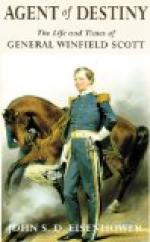At this time the entire military force in Florida amounted to four hundred and eighty-nine officers and men, and were distributed as follows: At St. Augustine, one company, fifty-three men; at Fort Brooke, on Hillsboro Bay, three companies, one hundred and fifty-three men; at Fort King, six companies, three hundred and fifty-three men. The Seminoles were located in the peninsula of Florida, a region of fens, swamps, and creeks almost inapproachable. They claimed that the Government had not carried out in good faith the treaties made with them. Their great leader and chief was Assiola, sometimes called Powell, and improperly spelled Osceola, whose father was a white man and his mother a woman of the Creek Indian tribe. Among most of the tribes of Southern Indians the children took rank from the mother. He was recognized among the Indians as a Creek. He did not inherit the title or place of a chief, but won it by his native ability, cruelty, and courage. In his early days he was insolent in his manners, and kept apart from the society of his people.
When General Alexander Ramsay Thompson was agent of the United States for these Indians, on one occasion Assiola appeared before him and announced that the lands claimed by the Government belonged to the Indians; that the Indians could take care of themselves, and did not need General Thompson’s services. He was arrested and placed in confinement, and after being imprisoned some time expressed regret, signed the treaty, and was released. Subsequently he rendered valuable service in arresting criminals, and regained the confidence of the whites. This confidence, however, was of short duration.
War having been declared in the name of the Florida Indians, a detachment of volunteers with some regulars, under General Duncan L. Clinch, moved to the Ouithlacoochee, the Indian encampment. Three days before the event which will be described as occurring at Ouithlacoochee, Major Francis Langhorne Dade, with a small command, had moved from Fort Brooke to relieve the post of Fort King. Major Dade and his command had marched sixty-five miles in five days, intrenching themselves each night in their encampment. On the sixth night they were attacked by Indians and negro allies, and out of one hundred and twelve all were slain except three. The officers killed were Major Francis Langhorne Dade, Captain George Washington Gardiner, Captain William Frazier, Lieutenants William E. Basinger, J.L. Keayes, Robert Richard Mudge, Richard Henderson, and Dr. John Slade Gatlin. Total killed, officers and men, one hundred and seven; escaped, three. A handsome monument has been erected to their memory at West Point. Returning to General Duncan L. Clinch’s advance on Ouithlacoochee, here he was attacked by Assiola and his followers after he had crossed the river; but the general succeeded in repelling the attack and driving the Indians. While the battle resulting in the massacre of Major




